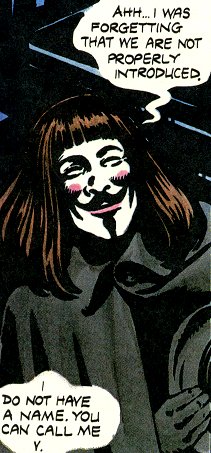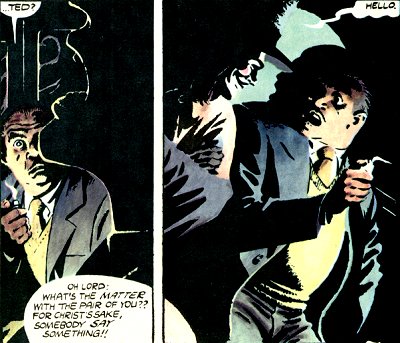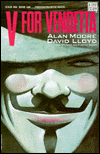
$17.50, 286 pages, a story in three parts
by Alan Moore & David Lloyd
Rating:
The first two parts were originally serialised in the UK's Warrior in 1982-83; the finished series was reprinted in 10 issues by DC in 1988-89, and in paperback form in 1990. A "Vertigo" stamp has since been added.
![]() Any serious superhero reader eventually gets around to reading Alan Moore
& Dave Gibbons' Watchmen. It's required. But unless they mistake the
cover painting for the Joker, superhero fans are less likely to pick up
V for Vendetta, Moore's more reality-based work from the same period.
They should. So should anyone with an interest in issues of the day like
individuality, the role of the state, and violence as a means to an end.
Any serious superhero reader eventually gets around to reading Alan Moore
& Dave Gibbons' Watchmen. It's required. But unless they mistake the
cover painting for the Joker, superhero fans are less likely to pick up
V for Vendetta, Moore's more reality-based work from the same period.
They should. So should anyone with an interest in issues of the day like
individuality, the role of the state, and violence as a means to an end.
![]() The book begins in fascist Britain of 1997. (I'm reviewing it now to get
the jump on all the people who will haul it out for an ironic compare-and-
contrast job around "the Fifth of the Eleventh, Nineteen-Ninety-Seven".)
Begun in the early 80's, the story's setting is already compromised by
actual history, but the story itself holds up well. The details of how
Britain slipped into fascism weren't Moore & Lloyd's point. The point is
what one might do if (when?) it did.
The book begins in fascist Britain of 1997. (I'm reviewing it now to get
the jump on all the people who will haul it out for an ironic compare-and-
contrast job around "the Fifth of the Eleventh, Nineteen-Ninety-Seven".)
Begun in the early 80's, the story's setting is already compromised by
actual history, but the story itself holds up well. The details of how
Britain slipped into fascism weren't Moore & Lloyd's point. The point is
what one might do if (when?) it did.
![]() I won't bother describing the setting in any more detail; the creators do
a fine job of that themselves, which I wouldn't want to short-circuit.
I won't bother describing the setting in any more detail; the creators do
a fine job of that themselves, which I wouldn't want to short-circuit.
![]() One note, however, for non-Brits: You might want to take a few minutes
before reading V for Vendetta to acquaint yourself with Guy Fawkes.
VforV's original audience was British, so Moore & Lloyd assume that
the reader is familiar with this well-known figure from their history. You
might also want to read up on Che Guevara, Siddhartha Gautama, and
Sojourner Truth... they have no direct relevance to V for Vendetta,
but they're also fascinating historical figures. {grin}
One note, however, for non-Brits: You might want to take a few minutes
before reading V for Vendetta to acquaint yourself with Guy Fawkes.
VforV's original audience was British, so Moore & Lloyd assume that
the reader is familiar with this well-known figure from their history. You
might also want to read up on Che Guevara, Siddhartha Gautama, and
Sojourner Truth... they have no direct relevance to V for Vendetta,
but they're also fascinating historical figures. {grin}

![]() The art is dark and moody throughout, like the 1930's gangster-movie comics
Moore and Lloyd originally set out to create. With minimal captions, no
sound effects, and few thought balloons, there's a heavy burden on the
artist to communicate the story. Lloyd's characters can be a little hard
to tell apart at times (in part because there are so many middle-aged,
white, male government functionaries in the supporting cast), but I rarely
had trouble telling what was going on.
The art is dark and moody throughout, like the 1930's gangster-movie comics
Moore and Lloyd originally set out to create. With minimal captions, no
sound effects, and few thought balloons, there's a heavy burden on the
artist to communicate the story. Lloyd's characters can be a little hard
to tell apart at times (in part because there are so many middle-aged,
white, male government functionaries in the supporting cast), but I rarely
had trouble telling what was going on.
![]() As you might guess, the letter "V" is a theme: It's the codename of the
central character, a recurring motif, and the name of every chapter in the
story starts with that letter. (I suppose it was inevitable that it would
one day be published by Vertigo.) Again, it helps to be familiar with the
cultural allusions: "V for Victory", and all that. It's a testament to
Moore's writing that this element doesn't come off as trite or hokey.
As you might guess, the letter "V" is a theme: It's the codename of the
central character, a recurring motif, and the name of every chapter in the
story starts with that letter. (I suppose it was inevitable that it would
one day be published by Vertigo.) Again, it helps to be familiar with the
cultural allusions: "V for Victory", and all that. It's a testament to
Moore's writing that this element doesn't come off as trite or hokey.
![]() There's a tremendous build-up in the first part of the book, particular
on the point of who V is and what he's up to. Unfortunately, like with
most Mysterious Elements, it fizzled a bit by the end, though Moore did
an admirable job of sustaining it... and even giving a perversely
satisfying (to me, at least) conclusion to the whole question.
There's a tremendous build-up in the first part of the book, particular
on the point of who V is and what he's up to. Unfortunately, like with
most Mysterious Elements, it fizzled a bit by the end, though Moore did
an admirable job of sustaining it... and even giving a perversely
satisfying (to me, at least) conclusion to the whole question.
![]() V for Vendetta was groundbreaking for its day, tackling serious issues with a weight
not often seen in funny books... even today. Sure, there's the horror of nazi-esque camps to expunge those of unwanted races, orientations, and values; and the corruption of power. But more importantly, it left me struggling with myself over the ethics and morals behind V's actions; I'm not sure yet whether I agree with them or not. It certainly gives me a
different perspective on anarchy and its relationship as one alternative to fascist dictatorship.
V for Vendetta was groundbreaking for its day, tackling serious issues with a weight
not often seen in funny books... even today. Sure, there's the horror of nazi-esque camps to expunge those of unwanted races, orientations, and values; and the corruption of power. But more importantly, it left me struggling with myself over the ethics and morals behind V's actions; I'm not sure yet whether I agree with them or not. It certainly gives me a
different perspective on anarchy and its relationship as one alternative to fascist dictatorship.
![]() So, go out and read this book. Then come back, and we'll discuss whether
V is a superhero or not. Or not. {smile}
So, go out and read this book. Then come back, and we'll discuss whether
V is a superhero or not. Or not. {smile}
![]()

![]() This book can be discussed in rec.arts.comics.dc.vertigo
This book can be discussed in rec.arts.comics.dc.vertigo
![]() More reviews of all kinds of comics
More reviews of all kinds of comics
![]() More reviews of comics that go Beyond Genre
More reviews of comics that go Beyond Genre
![]() More reviews of Sci-Fi comics
More reviews of Sci-Fi comics
![]() The main Beek's Books menu
The main Beek's Books menu
![]() Comments?
Comments?
© Todd VerBeek, Radio ZeroTM